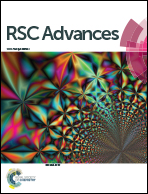Investigation on pH-switchable (itaconic acid/ethylene glycol/acrylic acid) based polymeric biocompatible hydrogel
Abstract
In this paper, a new variety of pH-sensitive polymeric hydrogels (IAE) have been developed and evaluated as biocompatible hydrogels using synergetic combinations of itaconic acid (IA), acrylic acid (AA), and ethylene glycol (EG) in water medium by free radical polymerization. The prepared hydrogels were characterised by FT-IR and SEM, which revealed the presence of functional groups and the morphological aspects of the IAE based hydrogels. The detailed swelling behaviour of various stoichiometric amounts of IAE based hydrogels has been studied at varying pH (1.2, 6.0, 7.4 and 10.0) with respect to time from 0 to 360 minutes. The comparative swelling equilibrium, biodegradation and biocompatibility studies of hydrogels have also been investigated. The antibacterial activities of the IAE based hydrogels were examined using pathogenic microorganisms viz. E. coli, S. aureus and B. cereus. Furthermore, the IAE hydrogels were also subjected to antifungal activity against Aspergillus niger & Candida albicans using the agar well diffusion method at various concentrations. The improved biocompatible properties of these gels imply that the IAE hydrogels have good potential for future biomedical applications in controlled drug release.


 Please wait while we load your content...
Please wait while we load your content...